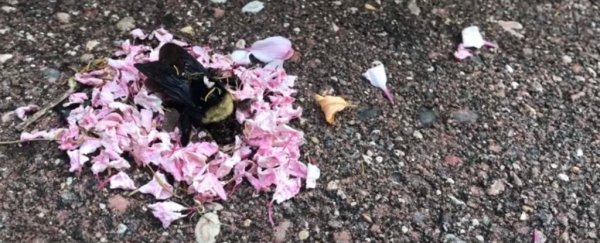It looks like something out of a sad fairy tale. Tiny ants are pulling over petals, making a pile, and on top rests a dead bumblebee.
The original video was posted by Minnesota resident Nicole Webinger, but has since been taken down - although there's no shortage of copies proliferating across the internet.
"Saw this outside of my work by the garden. There was a dead bumblebee, and we were watching the ants bring flower petals and leaving them around the bumblebee," she wrote in a post accompanying the video, according to reshareworthy.
"It looked like they were having a funeral for it."
The video is no doubt cool and unusual, but are we watching a never-before-observed ant funeral ritual? Probably not.
"It's a great video," behavioural ecologist Mark Elgar from the University of Melbourne told ScienceAlert.
"I'll use it for teaching first-year biology next year to illustrate the power of suggestion. The caption tells us that the ants are burying the bee in flower petals - how wonderful is that?"
But when we pause to think what we're actually seeing, it's just a few ants moving flower petals near a bumblebee surrounded by them, while other ants are milling about. Humans could interpret that as a ritual, but it's probably not a sweet inter-species funeral, as amazing as that would be.
But is there any method to what the ants are doing, or is it all just the power of suggestion? Well, there's some interesting stuff here to dive into.
As some people have noted, both ants and bees release a compound called oleic acid when they die. But bees have a habit of tossing the dead out of the hive or nest, whereas ants will transport their dead brethren to a midden heap.
Although the ants could be slowly taking the bee to their midden heap, it's actually unlikely - and the flowers wouldn't be part of it at all.
"The chemical signals that ants respond to can be context dependent, otherwise they'd be shifting dead things all over the place," Elgar explained to ScienceAlert.
"So they may be responding to oleic acid, some foolish workers trying to drag the bee into the nest. It's not quite as crazy as it might seem, but I think it's rather unlikely."
Others suggested that the ants might be hiding the smell of the dead carcass from other predators, before they chow down on it later. But if this was the case, we'd probably have seen more instances of this sort of behaviour - and ants are simply not known to do that.
Although "thinking outside of the box is always really helpful," says Elgar, "what the person is suggesting is that the ants are behaving in a completely different way in anticipation of something that hasn't formed part of their experience."
"That's a big ask for an ant."
As he notes, "concealing them with the odour of petals, it's a possibility, but it would really have to form part of the ants' repertoire."
Instead, the truth probably isn't that exciting at all.
"My guess is that the bee is sitting over the top of the ants' nest entrance, and that is why there is a number of petals sitting around the bee, including more ants arriving with petals," says Elgar.
Many types of ants use or eat plant matter (including flower petals). If a bee was perched over the ant nest entrance, the ants would struggle with what to do while they were carrying supplies to their digs.
But then, it could also just be humans being humans.
"Of course, it might be a complete set up. Someone actually put the bee there thinking this might happen, creating this lovely image."
Either way, rest in peace little bee.
